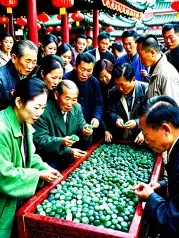In the bustling Delong Night Market, I strolled around after finishing my meal. The pathways were particularly difficult to navigate; the narrow alleys were crowded with stalls on both sides. The market was shrouded in darkness, illuminated only by the beams of flashlights held by nearly every visitor. These lights flickered chaotically along the sides of the path, creating an endless scene filled with people, all focused on one thing: jade.
The jade on display came in two forms. One was raw jadeite, encased in a layer of stone and mud known as "skin," commonly referred to as "gambling stone" in the trade. The other was already cut in half, termed "Test-cut jade," or divided into smaller pieces awaiting processing, which we referred to as "Exposed jadeite rough." As the name suggests, Exposed jadeite rough clearly revealed its internal quality and color, making it easier for buyers to assess its value based on experience and negotiation with the seller.
A piece of raw jadeite that had been cut was called Test-cut jade, while smaller pieces were simply referred to as Raw Material. Just a few minutes into my exploration, I witnessed a transaction. A buyer was eyeing a small piece of black-skinned gambling stone from Mo Mo Liang, which appeared to have decent quality despite its size. Mo Mo Liang is a site not far from Mo Wanji, known for its cement skin and good water content, making it a gamble for color inside.
As I approached the stall, I could see that they had already agreed on a price and were haggling. The seller initially quoted 20,000 yuan, but after some back-and-forth, they settled on 7,000 yuan for the small stone, which was then sent off to a cutter.
My master once told me that as a young jade carver, I was only allowed to purchase Raw Material. If I saw a piece that inspired me and I understood how to carve it, then I could buy it. However, I was only permitted to buy Exposed jadeite rough; even Test-cut jade was off-limits because it belonged to the category of "half-gambling material," which still held some uncertainty. As for raw stones like this small piece with skin intact, they were referred to as "full gambling material," leaving one completely unaware of whether what lay inside would be paradise or hell.
The saying "even the gods find it hard to judge a piece of jade" refers to the world of jadeite gambling stones. Just as I was contemplating my master's trust, the sound of grinding suddenly stopped. The onlookers turned their heads toward the machine, and then a heart-wrenching stream of curses erupted! Clearly, the cut had gone wrong. I muttered under my breath, "Isn't it better to buy a finished product for 7,000 yuan instead of cutting stones?"
Just as I was about to turn and leave, I heard a voice nearby say, "If you could cut a stone worth 700,000 yuan for 7,000, you wouldn't be saying that."
Who was that? I looked in the direction of the voice and saw a shadow approaching, which then slapped me on the backside with a loud clap.
A familiar figure came into view. This person, I knew well. If anyone could understand jadeite better than the gods themselves, it would be him: Bird Uncle.
In fact, Bird Uncle isn't really an uncle; he's a guy born in the '80s, just a few years older than us '90s jade carvers. However, he loves to act mature. When he opens his mouth, he often says things like, "I've lived through the collapse of the Soviet Union and the Cultural Revolution; back then, you were all just sperm."
I particularly admire Bird Uncle because he is incredibly skilled. Although those born in the '80s are now approaching their forties, in the traditional craft of jade carving, he is still considered part of the younger generation. As a "junior," Bird Uncle gained fame at a young age and has collected all the major awards available for jade carvers in China—Tian Gong Award, Shen Gong Award, Baihua Award—he has them all neatly tucked away. His works are both highly praised and commercially successful.
Moreover, instead of opening a carving factory with his earnings from jade carving, Bird Uncle ventured into the gambling stone business. What does this mean? It means he has money.





![]() 30
30
![]() 50
50
![]() 100
100
![]() 200
200
![]() 1000
1000
![]()
![]()
Comment 0 Comment Count